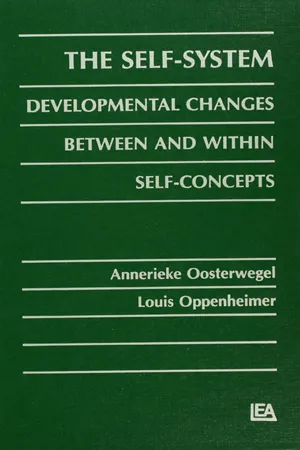Psychology
The Self Congruence and Conditions of Worth
The self-congruence theory suggests that individuals strive to maintain consistency between their self-concept and their experiences. Conditions of worth refer to the conditions that individuals believe they must meet to be accepted and loved by others. These conditions can lead to incongruence between the self-concept and experiences, resulting in psychological distress.
Written by Perlego with AI-assistance
Related key terms
Related key terms
1 of 4
Related key terms
1 of 3
3 Key excerpts on "The Self Congruence and Conditions of Worth"
- eBook - ePub
Self-esteem
A Guide for Teachers
- David Miller, Teresa Moran(Authors)
- 2012(Publication Date)
- SAGE Publications Ltd(Publisher)
While this perspective is widely accepted, it is not the only view of the relationship between self-concept and self-esteem. For example, Dennis Lawrence, whose publications on self-esteem have provided much helpful advice for teachers over the years, sees self-concept as an umbrella term consisting of three components: self-image, ideal self and self-esteem. This approach has links with earlier work by Carl Rogers, and can be represented by the following diagram:Figure 2.2 An alternative model of the relationship between self terms. Reproduced with permission from Lawrence, 2006, p. 3According to this model, the self-image is how we currently see ourselves; it is an awareness of our mental and physical characteristics. This seems consistent with its use in the previous diagram. The ideal self is a vision or a model of the person we would like to become. Self-esteem, according to this view, is how we feel about the difference between these two. Stated simply, if our self-image (how we currently see ourselves) is close to our ideal self (what we aspire to be) then our self-esteem is high. We are working towards achieving our goals. Rogers used the term congruence when the actual self or self-image and the ideal self are in harmony in this way. In contrast, if the gap between our self-image and our ideal self is wide, there is a lack of congruence and our self-esteem is correspondingly lower.Readers may detect similarities with the pioneering work of William James, mentioned earlier. It will be recalled that, for James, self-esteem was the ratio of our successes to our pretensions.But to return to our discussion about variations in terminology, yet another way of looking at the relationship between self-concept and self-esteem can be found in the writing of one of the leading authorities in the field of self-concept, Herbert Marsh. In his work, overall self-concept is synonymous with self-esteem (see for example, Marsh and Craven, 2006).Figure 2.3 A third model of the relationship between self-concept and self-esteemFrom this perspective, individuals make judgements about their abilities or performance in different contexts – for example, how successful they are in academic contexts, how competent they feel in social situations, and so on. When taken together, these various judgements combine to create an overall judgement about the self. This overall judgement is called general self-concept or global self-esteem - eBook - ePub
- Phillip Gammage(Author)
- 2012(Publication Date)
- Routledge(Publisher)
There are also questions of consistency and congruence. These loom large in social psychology, but here one may simply ask: what of consistency in objective and subjective perceptions of self? If one's self-evaluation is low, would that imply that one would wish to have that confirmed by others? After all, dissonance is difficult to deal with. There is also the process of rationalisation which occurs to varying degrees in adults and children. I may dance clumsily, but deny to myself and others the importance of this; thus the negative behavioural feedback is perhaps not so critical as, say, when I fail at a game of tennis, which means more to me. Then, too, one might consider discrepancies between the self, as ascertained by self (that is, the self-concept), and the self one would like to be (ideal self). Conflict here can be damaging and impose psychological strain on the individual. The relationship between anxiety and self-esteem is a curious one. Serious anxiety is consistently found to be a concomitant of negative self images. Yet it would appear that a certain degree of anxiety is necessary for an individual to be fully motivated to give of his best (see Chapter 5). Clearly, human behaviour is so complex that one should never try to explain it through the use of a single concept. But a great deal of research into human behaviour indicates the importance of considering both the structural context, and those relatively stable sets or dispositions of the individual which go to make up his or her personality. In the latter self-esteem appears to have a lot to offer to educationists. All the evidence points to well-adjusted children and adults evaluating themselves positively - eBook - ePub
The Self-system
Developmental Changes Between and Within Self-concepts
- Annerieke Oosterwegel, Louis Oppenheimer(Authors)
- 2013(Publication Date)
- Psychology Press(Publisher)
The motive for self-consistency involves people’s preference to be in congruence with their own real self-concepts. Self-consistency serves the experience of continuity. Several self-serving biases can be listed that are used by people to attempt to perpetuate their self-concept (e.g., Kulik, Sledge, & Mahler, 1986; Swann, 1987). Examples of more elaborate theories on self-consistency are those of Swann (e.g., 1983, 1987) on self-verification and Backman (1988) on interpersonal congruency. Self-verification (Swann, 1983, 1987) refers to people’s preference for self-confirmatory feedback and their efforts to acquire such feedback. Persons obtain information about themselves by feedback from others and from their own behavior in a particular context. Although the feedback from the social environment stabilizes the individuals’ self-concepts (Swann & Predmore, 1985), the individuals themselves may actively influence this feedback by creating idiosyncratically skewed social environments. People may communicate signs and symbols that are characteristic of their particular identity. People may avoid certain people and situations but seek out others. They may behave toward others in a way that stresses particular features of their self-concept, for example, by behaving authoritatively to stress their dominance. In addition, if people do receive feedback that is inconsistent with their self-concept, they can take steps to avoid it by looking away, for example, or forgetting, or attributing its causes to external factors (cf. Swann & Hill, 1982; Swann & Read, 1981).In Backman’s (1988) theory on interpersonal congruency it is assumed that people prefer and strive for congruency between their self-representations, their interpretations of behavior that is relevant to these self-presentations, and the relevant behaviors and perceptions of the environment. Three forms of congruency are distinguished by Backman: congruency by implication, by validation, and by comparison. Congruency by implication involves the perception that others ascribe characteristics to the individual that are also part of the individuals’ self-concept. Congruency by validation occurs when others behave towards the individual in accordance with the individual’s own self-concept. Congruency by comparison takes place when comparisons with others result in the individuals’ conclusion that others possess characteristics that are consistent with the individual’s self-concepts. Hence, congruency is achieved by several intra- and interpersonal processes, such as cognitive reconstruction, selective attention, selective evaluation, response evocation and self-presentation, and selective and biased comparison.Current research is no longer directed towards the confirmation of the individual’s active roles in either self-enhancement or self-consistency but in the relationship between both motives. Initially, it was found that individuals with high self-esteem tend to show self-enhancement, although individuals with low self-esteem tend to protect their selves and to strive for self-consistency. In accordance with these findings, Schlenker, Weigold, and Hallam (1990) reported that behavior motivated by self-enhancement was moderated by the individuals’ perception of the cost-benefit ratio (beneficiallity) and the credibility of the behavior. That is, people avoid self-enhancing behaviors that can easily be invalidated by others. According to Brown, Collins, and Schmidt (1988), people with low self-esteem also show self-enhancing behavior but, in contrast to people with high self-esteem, this behavior is shown in an indirect way. Swann, Pelham, and Krull (1989) stressed the recognition of the self-concept as a context-related multidimensional construct. These authors demonstrated that although people prefer self-enhancing feedback for their positive self-representations, they use self-consistent feedback for their negative self-representations. Furthermore, Swann and his colleagues (Swann, Griffin, Predmore, & Gaines, 1987; Swann, Hixon, Stein-Seroussi, & Gilbert, 1990) suggested a differentiation between the motive for self-enhancement and self-consistency on the basis of cognition and affect. They concluded that self-verification might need a more extensive cognitive processing of information than self-enhancement. Swann et al. (1987) found that consistent feedback was primarily related to cognitive responses, whereas enhancing feedback was primarily related to affective responses. Both motives were relatively independent, with affective responses occurring somewhat quicker than cognitive responses (Swann et al., 1987; cf. also Zajonc, 1980). When the cognitive loading was increased, people with low and high self-esteem reacted to enhance the self. Without such a cognitive load people with low self-esteem were more self-verificative (Swann et al., 1990).
Index pages curate the most relevant extracts from our library of academic textbooks. They’ve been created using an in-house natural language model (NLM), each adding context and meaning to key research topics.
Explore more topic indexes
Explore more topic indexes
1 of 6
Explore more topic indexes
1 of 4


